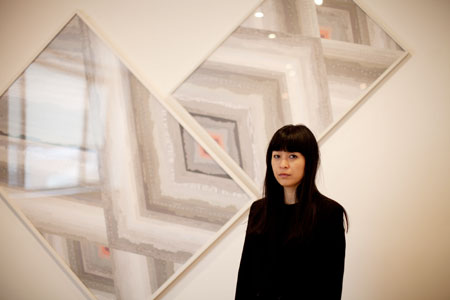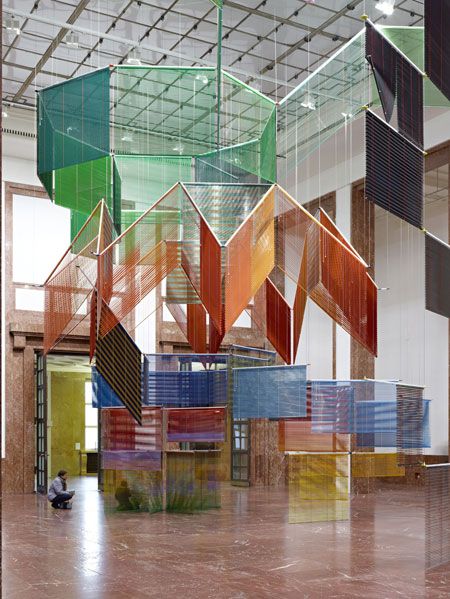
Yang Hae-gue unravels Diaspora at Haus der Kunst in Munich

The year 2012 was a splendorous year for Seoul- and Berlin-based Yang Hae-gue. She participated in dOCUMENTA (13) in Kassel, Germany and Urdaibai Art Biennale in Spain and presented “Dress Vehicles” at the newly opened Tanks at Tate Modern in London.
In November, Yang unveiled a new piece “Accommodating the Epic Dispersion — On Non-cathartic Volume of Dispersion,” a work she created for the Annual Art Commission at Haus der Kunst, Munich.
It is unusual for a foreign artist to grace the first annual commission of a German art museum, but Yang’s colorful Venetian blinds encompass the history of the building.
“I usually don’t like to work in a tight schedule, but this commission was tempting. My works on display at exhibits are generally displayed for a few months or even several days at art fairs. I liked the lengthy term of display provided by this annual commission,” Yang said at a recent interview with The Korea Times in December. The artist was on a short visit to Seoul.
The building of the Haus der Kunst has a long history. It was built in 1937 as part of a Nazi propaganda and used as an art museum until 1944. Since then, the building was used eclectically, including housing a casino for the United States army from 1945 to 1955 and various exhibitions until the 1990s. It became a contemporary art museum in 2003.
The middle hall is the place where Adolf Hitler gave an opening speech of the art institution showcasing “Germany’s finest art.” “I paid attention to the ever-changing history of the building. It was constantly being reborn and the place is filled with historical weight,” Yang said.

The classical design of the building also has a totalitarian mood and former directors covered up the walls to hide the history behind it. However, previous director Chris Dercon from Belgium started to take out the fake walls covering the original structure and current Nigerian-born director Okwui Enwezor launched the annual commission to continue bringing out the history.
“When I first saw the hall, I felt it was ‘heavy’ with historical burdens. I decided to change the atmosphere and shape the place with modernity,” the artist said. The theme for this work was “epic” as she wanted to embrace more time and space.
The long-titled work “Accommodating the Epic Dispersion — On Non-cathartic Volume of Dispersion” is inspired by the Diaspora. Her interest in the concept grew as she read books by Suh Kyung-sik, a Korean-Japanese professor at Tokyo Keizai University, studying the life of Koreans in Japan and Italian-Jewish chemist and author Primo Levi. “I am attracted to his methodology. His writings are not bellicose or accusatory, but have deep affections toward humanity,” she said.
She picked blinds, which were already used in many of her works including “Approaching: Choreography Engineered in Never-Past Tense” exhibited during dOCUMENTA, for the commission. “Blinds can easily work with the volume of the space. It can frame the space or divide it,” she said. “The space with blinds, without blinds and a third element of audience can create a new perceptions.”
The blinds used for this piece are colorful ranging from red and yellow to blue and green.
“I picked bombastic, primary colors for entrances and later mixed these colors for a stripe pattern. The blinds are flat, but it could frame a space when layered,” she said.
There is a grand narrative in the history as well as minor ones. These minor ones interconnect and create another narrative. Blinds are good materials to convey the mood of marginal community.”
She said it is difficult to be satisfied with her works over time. “I just embark on the next project when I finish one. It could be either happiness or unhappiness depending on how you see it,” she said.
Yet Yang sees another busy year this year. At least four major exhibitions are scheduled at the Museum of Modern and Contemporary Art in Strasbourg, France in May; Glasgow Sculpture Studios in Scotland and Bergen Kunsthall in Bergen, Norway in October; and Parasol Unit Foundation for Contemporary Art in London in November.
“I travel a lot because of my work and exhibitions, but the destinations are obvious. I might seem adventurous considering the amount of my works, but I’m rather not. There are a few places where a contemporary art museum is located and contemporary art is appreciated. Those are my limits and I have complaints about that,” Yang said.
Despite her international acclaims, Yang hosted few exhibitions in Korea. The last one was in 2011 at Artsonje Center and currently only two of her works are on display at the National Museum of Contemporary Art and Leeum.
“I know people think of me in an abstract way as I can’t present my works in Korea but only the news of overseas exhibitions are introduced to Korea,” she said.
She added that she hopes to hold an exhibit in her home country in 2014. <The Korea Times/Kwon Mee-yoo>


